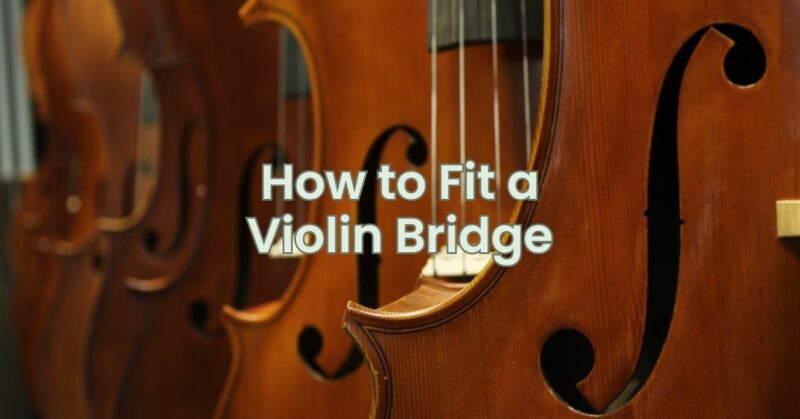The bridge is a crucial component of a violin, supporting the strings and transmitting their vibrations to the soundboard. Properly fitting a violin bridge is essential for optimal playability, sound projection, and tonal quality. In this article, we will guide you through the steps to fit a violin bridge, ensuring a precise and secure placement for your instrument.
- Assessing the Fit: Before fitting a new bridge, carefully evaluate the fit and condition of the existing bridge. If the current bridge is damaged, warped, or not properly aligned, it is advisable to replace it with a new one.
- Tools Needed: To fit a violin bridge, you will need the following tools:
- A set of bridge fittings, including the bridge itself, bridge feet, and bridge pins.
- A pencil or marker for marking the position of the feet.
- A bridge template (optional but helpful for precise measurements).
- A bridge-fitting tool (optional but can assist in adjusting the fit).
- Preparing the Bridge: Start by preparing the new bridge for fitting:
- Carefully examine the bridge for any imperfections or rough edges. Use fine-grit sandpaper or a file to smooth any rough areas, ensuring a clean and even surface.
- If necessary, shape the bridge’s top curvature to match the contour of the violin’s soundboard. Use a specialized bridge-fitting tool or a small piece of sandpaper to achieve the desired shape.
- Ensure that the bridge’s string notches are properly aligned and evenly spaced.
- Placing the Bridge: To fit the bridge onto the violin, follow these steps:
- Loosen the violin strings to reduce tension and facilitate easier placement of the bridge.
- Position the bridge approximately where it will be placed on the violin, aligning the feet with the designated area on the soundboard.
- Use a pencil or marker to mark the position of the bridge’s feet on the violin’s soundboard. This will serve as a reference point for accurate placement.
- Gently insert the bridge feet into the marked positions, applying even pressure and ensuring a snug fit.
- Align the bridge perpendicular to the violin’s body, ensuring that it is centered between the f-holes.
- Gradually tighten the strings, carefully monitoring the position and alignment of the bridge as the tension increases.
- Ensure that the bridge remains upright and properly aligned during the tightening process.
- Adjusting the Fit: After placing the bridge, assess its fit and make any necessary adjustments:
- Check the bridge’s height by measuring the distance between the top of the fingerboard and the bottom of the strings. The standard height is typically around 5-6mm for the G string and slightly lower for the E string. Use a bridge template for precise measurements.
- If the bridge is too high, carefully sand or file down the bottom surface of the feet, ensuring even adjustments on both sides.
- If the bridge leans forward or backward, gently manipulate the bridge’s position by applying slight pressure with your fingers. Take care to maintain proper alignment and avoid excessive force.
- Assess the string alignment over the fingerboard and adjust the bridge if necessary. The strings should be evenly spaced and parallel to the fingerboard, allowing for comfortable and accurate playing.
- Professional Assistance: If you are unsure about fitting the bridge yourself or encounter any difficulties, it is advisable to seek assistance from a professional violin maker or luthier. They have the expertise and experience to ensure the bridge is fitted correctly, optimizing playability and sound quality.
Conclusion: Properly fitting a violin bridge is crucial for optimal playability, sound projection, and tonal quality. By following the steps outlined in this article and paying attention to alignment, height, and string spacing, you can fit a bridge that enhances the performance of your instrument. Remember, if you are unsure or encounter challenges, it is always wise to seek assistance from a knowledgeable professional. With a well-fitted bridge, your violin will produce beautiful sound and provide a rewarding musical experience.

